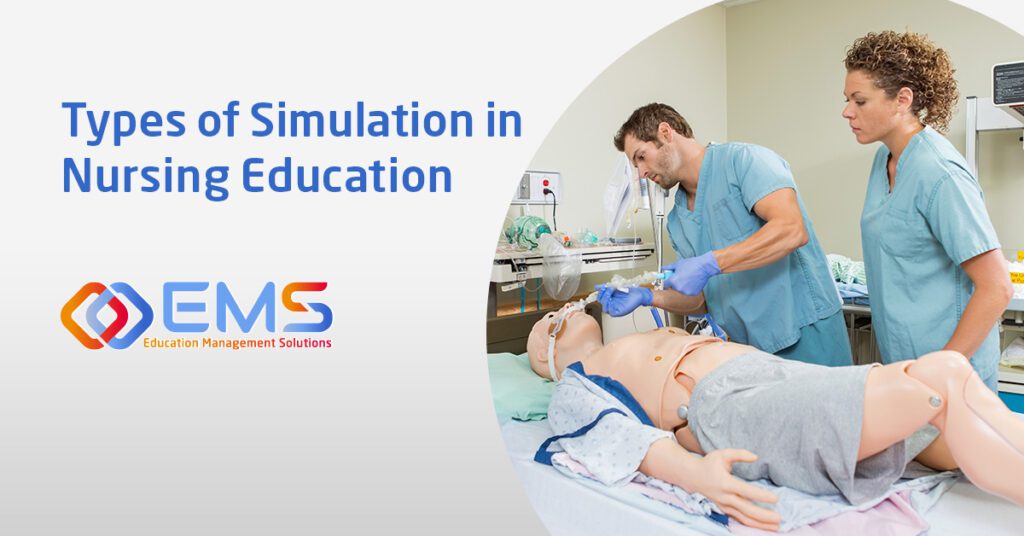Simulation plays a pivotal role in nursing education, offering a practical and immersive approach to prepare future healthcare professionals. In this article, we’ll explore various types of simulation in nursing education, such as standardized patients, role-playing, and low-fidelity manikins. We’ll examine how these variations of simulations benefit aspiring nurses and enhance their skills.
Some of the most common types of simulation methods used in nursing education include:
- Unfolding Case Studies: These dynamic scenarios evolve over time, challenging students with unpredictable twists and turns. Unfolding case studies provide a valuable platform for enhancing patient assessment skills. They encourage students to explore complex patient situations and offer a cost-effective learning option.
- High-fidelity Manikins: High-fidelity manikins, controlled by advanced computer systems, closely replicate patient responses, physiology, and anatomy. They are highly adaptable and come closest to simulating real patient experiences, making them a favored choice. However, their sophistication comes at a higher cost.
- Low-fidelity Manikins: Low-fidelity manikins encompass two-dimensional displays, static models, and partial-task simulators. While they lack realism, they enable students to learn at their own pace and master specific skills, such as CPR or intravenous insertion.
- Partial-task Simulators: These specialized tools, like isolated limbs or heads, allow nursing students to repeatedly practice specific skills without wearing out expensive equipment.
- Standardized Patients: Standardized patients, or SPs as they’re commonly referred to are volunteers or paid actors who realistically mimic clinical interactions from the patient side. Because learners are dealing with real people, SPs can enhance communication and assessment skill development, including history-taking, informed consent, explaining procedures, and delivering difficult news.
- Role-Playing: Role-playing prompts students to act out healthcare scenarios. This low-cost, low-fidelity approach doesn’t require props or elaborate settings but can significantly benefit students’ soft skills and encourages team bonding.
- Virtual Reality: Virtual Reality (VR) combines computer technology with standardized patients to create highly immersive simulations. Although relatively new, VR isgaining traction in healthcare education because of its ability to present healthcare scenarios that have been too complex or costly to demonstrate with traditional simulation methods up until this point.
- E-learning: E-learning encompasses computer-based simulations, from instructional videos on device usage to intricate virtual reality scenarios where students interact with patients and healthcare professionals.
- Combined Simulations: Combining two or more simulation techniques creates multifaceted, realistic scenarios. This approach allows students to practice multiple skills simultaneously. For instance, an instructor could attach a suture cushion to a standardized patient, enabling students to practice suturing while obtaining informed consent and explaining the procedure.
Benefits of Simulation in Nursing Education
Simulation offers a number of benefits for nursing students, including:
- Improved skills and competence: Simulation allows students to practice their skills in a safe and controlled environment. This can help them to develop the confidence and competence they need to provide safe and effective patient care.
- Risk-Free Learning: Simulation provides a risk-free learning environment where students can make mistakes without harming real patients. This fosters a culture of experimentation and learning from errors, ultimately improving patient safety.
- Enhanced critical thinking skills: Nursing simulations encourage critical thinking and decision-making. Students must assess patient conditions, prioritize actions, and adapt to evolving situations, enhancing their problem-solving abilities.
- Teamwork and Communication: Nursing often involves multidisciplinary teamwork. Simulations provide a platform for students to collaborate with peers and practice effective communication, which is vital in healthcare settings.
- Evaluating Competency: Simulations offer a reliable method for assessing nursing competency. Instructors can objectively measure a student’s performance and identify areas for further development.
Simulation in nursing education serves as a valuable tool that not only imparts crucial skills but also enhances students’ overall readiness for the complex and dynamic healthcare environment.

